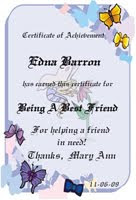On the front page of the newspaper today, there is a big picture of the face of the "Craig's List" killer. My heart actually hurts. To look at this face, you think, this is what I want my son to be like, handsome, smiling, likable, friendly, smart. How can we be so wrong? How does a child grow up to be so evil? Was it something that we as parents caused or could have prevented? Will we ever know?
Inside the newspaper, is our weekly smaller paper which gives tips and tricks for better living, among other things. Today my favorite article is "Go Green, Your Way." Have you started going green yet? What are you waiting for? It's good for Mother Earth, it's good for nature, and it's good for us.
I will share some tips with you. FREE: For Spring cleaning, wipe up with old t-shirts and dishcloths instead of buying sponges or using paper products that will just end up in a landfill. CHEAP: Make your own cleaning products with baking soda, vinegar, lemon juice and olive oil (recipes can be found at spryliving.com/green). ECO-INVESTMENT: Purchase cleaning products made with toxin-free and biodegradable ingredients.
Others include: ** Unplug electronics when they're not in use to save "phantom energy" that can add up to 5% to your electricity bill each year. ** Switch to cold water for every load to make a huge impact. About 90 % of the energy required to wash clothing is used to heat the water. ** Drive the speed limit to save gas - and 13 to 42 cents per gallon.
If you have any other green suggestions, please pass them along and I'll put them here to share with everyone. Changing over to green is fairly painless and so good for all of us. We only have one earth, and we all need to pull together to save her.
Before I call it a day, I have to share one other thing with you. I just looked down at my keyboard, and over on the bottom right corner it says : "Warning --- To reduce risk of serious injury, read Safety & Comfort Guide provided with product." Okay - now I'm not a stupid person, but how am I going to seriously injure myself with this keyboard? Unless I pick it up and bash myself over the head with it, I'm really at a loss here. Can anyone help me here?
Maybe one of my dwarfs knows? Well, anyway, y'all have a grand day.
Hugs, Edna B.














+03-15-10.jpg)






Award_Yanti++11-11-09.jpg)


.gif)

.jpg)




.jpg)







.jpg)
.jpg)
.jpg)



2 comments:
Next green tips: Buy refills ! A lot of brands offer refills for their bottles- less waste.
Always take your own shopping bags along-I use cloth bags , if they are dirty they just go into the washing machine.
If you have a baby, use washable cloth nappies - did you know that the usual nappy from the store takes about 10years before it degrades? How much waste would we save if only half of the mums would use washable nappies?
If you have a garden , don't go for chemicals straight away if you have problems with greenflies, snails or other pests- there are natural sloutions -example: plant onion next to other plants- a lot of insects don't like the smell and will not go anywhere near it,lol.
Lemon balm keeps flies and moscitos away.You can google a lot more of eco-friendly garden tips.
Important: the plastic ring fasteners which are used around a lot of 4 or 6 packs of cans make animals suffer. Dolphins, birds and other animals have been found with these plastic rings around face, necks, legs etc, the plastic cuts into their skin while they struggle to get free- always cut the loops open before throwing into the bin.
Hugs Snowy
A bi-product of this computer revolution has been an increased occurrence of carpal tunnel syndrome, or CTS. Continued, repetitive movements such as using a keyboard can damage the tendons that run from the hands to the forearms. If not dealt with properly, this damage progresses and causes extensive pain and limited hand use.
Within the hand and wrist there is a collection of bones, tendons and nerves. This area is tunnel-shaped and not very roomy. If you flex your hand over and over again, as you do when you type, you cause these tendons in your wrists to rub against each other, leading to irritation. The irritation results in swelling, and those swollen tendons then press against what is called the median nerve, causing tingling, numbness and eventually significant pain.
By monitoring your body positions and what activities you are doing with your hands, you can function somewhat normally if CTS is already present. But most importantly, you need to learn what proper ergonomics (work place design) and work habits can do to live free of CTS:
Chairs - Wheeled, adjustable height chairs with armrests are ideal.
Tables - Choose a table or desk height that allows your arm to sit at a 90-degree angle to your body. 27 to 29 inches above the floor is recommended.
Wrist angle - Adjust your keyboard height, or use wrist rest, so wrists are aligned with forearms while working. Consider changing your style of keyboard, using a track ball or a different mouse if you cannot achieve this position otherwise.
Elbow angle - Raise your seat height if your arm angle is less than 90 degrees. Lower it if it is more than 90 degrees.
Waist angle - Your waist should be 90 degrees to your legs when seated. If it is less, raise chair height. If the angle is greater, lower the chair height.
Feet - Feet should touch the floor. Use a footrest or different chair if this is not the case.
Work habits - Take a short break every 10-15 minutes. Vary your tasks as much as possible.
Stretching - Strengthen and stretch your hands often.
Clench your fists, hold, then spread your fingers out and hold. Repeat.
With outstretched arms, repeatedly raise and lower your hands.
Rotate your wrists repeatedly.
There are many kinds of CTD medical conditions that have ergonomic causes among office workers, including carpal tunnel syndrome and various kinds of tendon inflammation. Some other disorders, such as myofascial pain syndrome, fibromyalgia, thoracic outlet syndrome, and reflexive sympathetic dystrophy are believed to be the results of cumulative trauma in some cases.
Because of the complexity and subtle differences between disorders, physicians don't always diagnose CTD's correctly or easily. The most knowledgeable medical specialists for CTD's are generally considered to be physiatrists, or physical medicine specialists.
2. CTDs can happen when there is very little repetitious work. Besides repetition, other possible causes include:
Holding one position. Muscles that hold a body part in position for long periods are more prone to fatigue than muscles that move a body part around.
Non-neutral postures. In this context, "posture" is the position of an individual joint, not overall body posture. Any posture significantly different from "neutral" is considered to be at risk for musculoskeletal distress. "Neutral" is considered to be the position about halfway through the available range of motion for the joint.
Localized pressure. Direct pressure on nerves or tendons can cause damage in the long run. The wrist is one location of concern. The elbow (the funny-bone or crazy-bone nerve) is another.
Use of force. Even small exertions can cause stress if small muscles are involved. Sudden, fast motions involving a jerk or snap.
Cold temperatures.
Vibration, as with hand-held power tools or whole-body vibration as caused by driving heavy equipment
Hmm-does that make it any clearer? These are part of our Health and Safety at work , and our desks and chairs are fitted to comply with these sort of regulations.
Hugs Snowy
Post a Comment